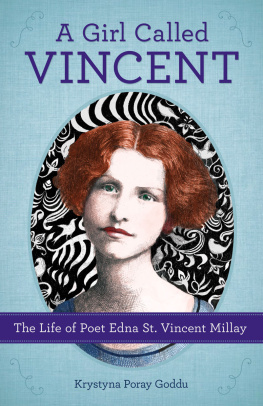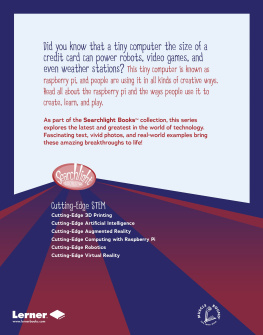

T here was never anything calm about Vincent. Her sisters used to say that she had a bee chasing her. Edna St. Vincent Millay (18921950), known as Vincent, was an acclaimed American poet who came to embody the modern, liberated woman of the Jazz Age. From the fiery energy of her youth to the excitement and acclaim of her early adulthood in New York and Paris, to the demands of living in the public eye, Vincents life was characterized by creativity, hard work, and passion. A Girl Called Vincent traces her incredible journey from a unique and talented girl to an international celebrity and Pulitzer Prizewinning poet.
Raised in poverty in rural Maine, where she was often the sole caretaker of her two younger sisters, the rebellious, creative, red-haired Vincent always found time for writing, acting, singing, and playing piano. She became a sensation in young adulthood, bewitching audiences with her words, voice, and luminous appearance. She mixed with the literary figures of her time and broke many hearts. Her volumes of poetry were enormous bestsellers and audiences nationwide went wild when she recited her works onstage. In addition to poetry, Vincents body of work includes plays, translations, and an opera, and ranges from love sonnets to antiwar propaganda.

Copyright 2016 by Krystyna Poray Goddu
All rights reserved
Published by Chicago Review Press Incorporated
814 North Franklin Street
Chicago, Illinois 60610
ISBN 978-1-61373-172-7
Library of Congress Cataloging-in-Publication Data
Goddu, Krystyna Poray.
A girl called Vincent : the life of poet Edna St. Vincent Millay / Krystyna Poray Goddu.
pages cm
Includes bibliographical references and index.
ISBN 978-1-61373-172-7 (cloth)
1. Millay, Edna St. Vincent, 18921950. 2. Poets, American20th centuryBiography. 3. Women and literatureUnited StatesHistory20th century. I. Title.
PS3525.I495Z6365 2016
811.52dc23
[B]
2015032432
Interior design: Sarah Olson
Permission to reprint photographs and quoted text from poems, letters, and diaries, published and unpublished, is granted by The Permissions Company, Inc., on behalf of Holly Peppe, Literary Executor, The Millay Society. www.millay.org.
Printed in the United States of America
5 4 3 2 1
This book is dedicated to the memory of Jack Scaparro (19352012) fellow writer, fierce champion, longtime friend

In your day, this moment is the sun Upon a hill, after the sun has set.
Edna St. Vincent Millay
Contents

Index
Introduction

W hen I was about 12 years old, I found these words in a poetry book:
All I could see from where I stood
Was three long mountains and a wood.
I turned and looked another way
And saw three islands in a bay.
The words were simple, and they made me want to be in that beautiful place where I could see three islands in a bay, three long mountains, and a wood. I kept reading. Over these things I could not see / These were the things that bounded me.
Hmm. Now I wasnt sure what the poem was really about. It was a very long onemore than 200 linesbut the rhythm of the words, the very clear images, and the stirring emotions kept me reading. By the time I had finished it, I was puzzled, moved, and intrigued all at once. I started reading it again.
That poem was Edna St. Vincent Millays Renascence, and I have never forgotten the experience of reading it in my attic bedroom, over and over again, feeling chills and heat and fascination. I was a young girl who believed herself a poet, and this poem was deeply inspiring.
I started to learn more about Edna St. Vincent Millay, and found out that she was only 19 years old when she wrote this poem. Her life seemed amazing to me. It sounded romantic and exciting. Known to her family and friends as Vincent, she was a tiny, red-haired, high-spirited girl who loved to write poems, plays, and music, and to perform. She grew up to be a tiny, red-haired, high-spirited woman, who became known as one of Americas greatest poets. When she appeared onstage to recite her poetry, audiences went wild at the sight of the slight figure in the long silk gown. Men and women sent her flowers and love notes. Can you imagine an audience going wild for a poet? That was how people reacted to Vincent.
How did that little girl become such a sensation, who bewitched audiences with her words, her voice, and her appearance? How did a girl raised in poverty in rural Maine grow into an international celebrity? And how did she come to write poems that still make us tingle when we read them today?
There is one word that captures the essence of Edna St. Vincent Millay and her writing: passion. She was a girl who, from her earliest years, threw herself at the world, taking everything she wanted from it and turning her life and all its experiences into stirring poems. One of her most well-known poems sums up her approach to life:
My candle burns at both ends;
It will not last the night;
But ah, my foes, and oh, my friends
It gives a lovely light!
The life of Edna St. Vincent Millay was filled with adventure, art, beauty, love, and, sometimes, pain. I believe that her story teaches us to face life with eagerness and honesty, to work for what we desire, to be brave in small moments and big ones, to live as we believe is right for us, and to appreciate and exhilarate in the worlds beauty.
When Vincent was 20, in a letter to a new friend who questioned whether her poem was about something she found in a book, she wrote indignantly, Ill slap your face! I see things with my own eyes, just as if they were the first eyes that ever saw, and then I set about to tell, as best I can, just what Ive seen.
In this book, I try to look at Vincents story with my own eyesboth the eyes of the girl who discovered her poetry and those of the woman who appreciates what it took to live her lifeand to tell her story as best I can.

A Girl Called Vincent
18921904
A s the baby emerged, she appeared to be wearing a thin, translucent veil over her face. The doctor attending the birth quickly reached out his hand to wipe away the transparent covering, and the newborn gave her first lusty cry.
Her family instantly grasped the omen: this was no ordinary child who had come into the world. The red-haired infant had been born with a caul, a thin membrane covering her face, a rarity and a signfor those who believe in such thingsthat the person is destined for an extraordinary life.
Next page













